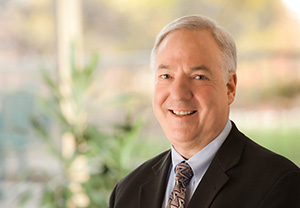June 1, 2014:
A conversation with Ken Cowan, MD, PhD, director of Fred & Pamela Buffett Cancer Center, which is a member of the Big Ten Cancer Research Consortium:
Q: What kind of impact do you see the Big Ten CRC having on cancer clinical trials?
Researchers can work together to turn ideas into potential new treatments. The clinical trials developed will link to molecular diagnostics, enabling researchers to understand what drives the cancers to grow and what might be done to stop them.
Q: What kind of scientific developments happening at Fred & Pamela Buffett Cancer Center are changing the way we diagnose and treat cancer?
Through the use of genomics and other new diagnostic tools, we will employ precision medicine to customize therapies and care for each person cancer touches.
Virtually every human disease is rooted in our genes. For many years, doctors have understood that genetics were linked to a few diseases and conditions that had a simple, predictable inheritance pattern caused by a change in a single gene.
Cancer is more complex — but may be just as predictable. Many genetic mutations drive a cancer. Utilizing genomics — studying all the genes in a person and how they interact and are influenced by environmental factors — the Fred & Pamela Buffett Cancer Center will produce revolutionary new cancer therapies.
No two patients are the same. Their cancers are not the same. Their treatments shouldn’t be the same. By mapping the genetic driver in each patient’s cancer and delivering precise therapies, we will improve that person’s chance for survival and recovery.
While all forms of cancer will be treated, the Fred & Pamela Buffett Cancer Center is initially best positioned to make global contributions in six areas: Breast Cancer and Women’s Cancers, Head and Neck Cancers, Leukemia and Lymphoma, Lung Cancer, Pancreatic and Gastrointestinal Cancers, and Prostate Cancer.
Q: How will the new Fred & Pamela Buffett Cancer Center facility help to advance cancer research and care?
From the moment the doors open in 2017, the Fred & Pamela Buffett Cancer Center will be different. For too long, scientists focused on cancer research and physicians treating patients in clinics have worked independently.
Academic, research and clinical silos have impeded the progress we all seek for cancer diagnosis, treatment and recovery.
By uniting cancer physicians and scientists, our cancer center is specifically designed to spark collaboration and discovery. Extraordinary patient care and scientific breakthroughs will take place together, creating a synergistic precision. Science and medicine will share not just a common space, but also a common goal.
The new $323 million Fred & Pamela Buffett Cancer Center, the largest project ever on campus, was named in recognition of a gift from Pamela Buffett, through her foundation, the Rebecca Susan Buffett Foundation. Pamela’s husband, Fred “Fritz” Buffett, died in 1997 after fighting kidney cancer.
The Fred & Pamela Buffett Cancer Center includes:
- A 10-story, 98-laboratory research tower named the Suzanne and Walter Scott Cancer Research Tower;
- A seven-story, 108-bed inpatient treatment center named the C.L. Werner Cancer Hospital; and
- A multidisciplinary outpatient center.
Q: How will being a part of the Big Ten CRC differ from other collaborative efforts your center has been a part of?
The consortium creates a unique team-research culture. At the Big Ten CRC, cancer leaders collaborate with and mentor research leaders of tomorrow with the common goal of improving the lives of all cancer patients. The consortium provides junior faculty and fellows the opportunity to write, conduct and complete trials, which is typically not available at single institutions or on a national level for young investigators.
About the Big Ten Conference: The Big Ten Conference is an association of world-class universities whose member institutions share a common mission of research, graduate, professional and undergraduate teaching and public service. Founded in 1896, the Big Ten has sustained a comprehensive set of shared practices and policies that enforce the priority of academics in student-athletes’ lives and emphasize the values of integrity, fairness and competitiveness. The broad-based athletic programs of the 12 Big Ten institutions provide in excess of $141 million in direct financial aid to more than 8,200 student-athletes playing on more than 300 teams in 43 different sports. The Big Ten sponsors 26 official conference sports, 13 for men and 13 for women, and will add men’s and women’s lacrosse as the 27th and 28th official sports for the 2014-15 academic year. For more information, visit www.bigten.org.

















Subscribe to the Big Ten CRC Newsletter X
X Facebook
Facebook YouTube
YouTube